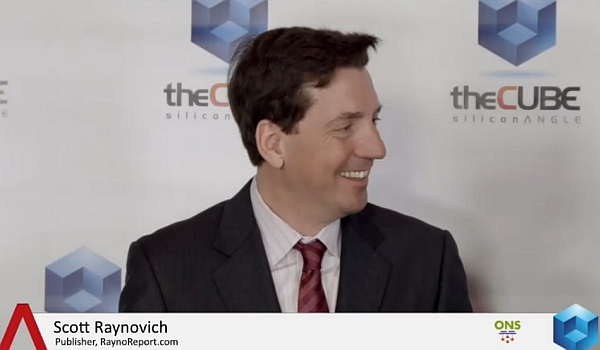 NEWS
NEWS
 NEWS
NEWS
 NEWS
NEWS
![]() John Furrier and Dave Vellante, theCUBE co-hosts, traveled again to Santa Clara to attend the Open Networking Summit 2014. The event brought together engineers, business leaders and researchers, aiming to explore and share the key developments and in the quickly-evolving world of OpenFlow/SDN.
John Furrier and Dave Vellante, theCUBE co-hosts, traveled again to Santa Clara to attend the Open Networking Summit 2014. The event brought together engineers, business leaders and researchers, aiming to explore and share the key developments and in the quickly-evolving world of OpenFlow/SDN.
Trying to find out how open source is going to transform the show, Furrier and Vellante got hold of Scott Raynovich, Publisher with The Rayno Report and an esteemed industry analyst. Together the three of them discussed the future of networking, the growing change of cloud, as well as the past and present internet bubbles.
“What’s your take on the landscape?” asked Furrier, prompting Raynovich to elaborate on the business impact of the open source.
“It’s like the mini version of the optical bubble in the 1999-2000, but more chaotic; it’s a huge shift,” answered Raynovich.
.
Debating the transition of Cisco from disrupted to disruptor, everyone agreed that the acquisition of Insieme couldn’t have come at a better time.
Noting that Cisco is a behemoth which owns two thirds of the market, Vellante asked how they maintain their market share.
“Cisco’s strengths are sales and marketing and they are an acquisition machine. In the early 90’s they rolled up all the Ethernet start-ups and that’s how they acquired their market share. After their success they got a bit distracted and got away from their roots,” said Raynovich, referring to Cisco acquisition of Flip Video.
“Their roots are in network administration, service providing, communication – and they should stay true to their roots. Insieme is probably their most important deal in five years,” reckons Raynovich. “With these new acquisitions they are going to sink-or-swim.”
However, history has shown that when you have 60+ market share, you are harder to knock over.
“Cisco has great competitive strategies” thinks Furrier. “You can not just unwind Cisco. Cisco is fine, a bit challenged, but I am interested, how do they work with the ecosystem and the cloud? It is a cultural shift.” The other legacy vendors, like Juniper, are not even at the show.”
“More people should be at the show. If you do not show up, the market perception will be indecision; you got to come up with a story,” said Raynovich.
.
“Is the Insieme move going to allow Cisco to maintain their 66 percent market share?” asked Vellante. “VMware is donating code to the OpenStack to try to get some traction. Is there traction with Nicira?”
“VMware is coming from the server/software side, while Cisco is coming from the networking / hardware side. It’s completely different perspectives, in terms of who are you talking to and who are you selling to. It’s interesting that the story of the SDN market is that we’re told these markets will eventually merge into one. The networking boxes will be servers and the servers will be networking boxes, you are breaking down and integrating the silos. VMware and Cisco have most of those tools, the question is who gets there faster,” commented Raynovich.
Furrier then invited Raynovich to elaborate on the power of DevOps, the current business model and the SDN analysis. Scott seems to believe that “2014 is going to be the reality check for SDN start-ups: companies like Big Switch and Cumulus are out there, getting their third round of financing. VCs decide whether they double down or pull the plug.”
Talking about revenue and the Internet bubble, Furrier ended up asking Raynovich where he thinks lies the bubbles of today. He nominated the controller market. Vellante, on the other hand, sees open source as a wild card. “What are the major trends and how do they impact the networking world?” he asked.
“At the fundamental level, SDN is defined as separating the operating system from the networking hardware; traditionally the market has been proprietary operating system / proprietary networking hardware. Juniper and Cisco sell their operating systems,” so it just goes to show how chaotic the market is at the moment, Raynovich said.
Wrapping up the segment, Furrier shared his observations on the openness impact on the market in general and the networking in particular.
“The #1 force that I see is that the DevOps cloud model: forcing function to the networking world where it’s predicating movement. You have to move or die. You see the applications growth forcing what was traditionally an edge of the network concept to be application specific. Virtualization enables that, so I see that as a driver.”
Furrier continued: “You see an operating system software mindset coming into networking – which is interesting as you have system guys, network guys and CS guys, blending together. You have a 3 tier of thinking. Everything as a service, logical design with virtualization, mapping of the physical infrastructure,” these are just a couple of trends.
Support our mission to keep content open and free by engaging with theCUBE community. Join theCUBE’s Alumni Trust Network, where technology leaders connect, share intelligence and create opportunities.
Founded by tech visionaries John Furrier and Dave Vellante, SiliconANGLE Media has built a dynamic ecosystem of industry-leading digital media brands that reach 15+ million elite tech professionals. Our new proprietary theCUBE AI Video Cloud is breaking ground in audience interaction, leveraging theCUBEai.com neural network to help technology companies make data-driven decisions and stay at the forefront of industry conversations.